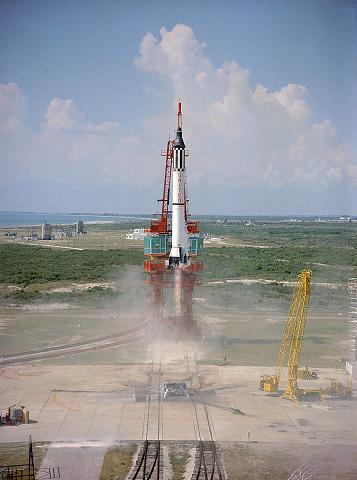The adventure started on October 4, 1957, when the former Soviet Union successfully launched the first artificial satellite, Sputnik-1, using a rocket that was a modified Intercontinental Ballistic Missile (ICMB). Even if the political implications at that time were very important, as the launch ignited the Space Race within the Cold War, we can argue that the scientific accomplishments were more significant.
These accomplishments relied upon the theoretical work of scientists like Hermann Oberth and Konstantin Tsiolkovsky.
What followed this event, as mentioned above, was a race.
Explorer-1, the first American artificial satellite, was launched on January 31, 1958. Yuri Gagarin was the first human in outer space and the first to orbit the Earth on April 21, 1961. He was followed closely by Alan Shepard, who became the first American to travel into space onboard the Freedom-7 capsule, on May 5, 1961.
On August 19, 1964, the first geostationary communication satellite, Syncomm-3, was placed in orbit over the International Date Line. Syncomm-3 was used to relay the television coverage of the 1964 Summer Olympics in Tokyo, Japan, to the United States. The first to propose the concept of a communication satellite was Arthur C. Clarke, who in October 1945 published an article in the British magazine Wireless World that described the fundamental concepts behind the development of artificial satellites used to relay radio signals.
The first space station, Salyut-1, was launched on April 19, 1971. Even if the space station had a short operational life, as it re-entered the Earth atmosphere on October 11, 1971, it tested elements of the systems required on a space station and conducted scientific research and experiments. The construction of the first international research facility in Earth orbit, the International Space Station (ISS), began in 1998. The station is still under construction and it will be operational until at least 2015.
Where are we now, after 53 years of exploration of the space in the proximity of Earth? Since the launch of Sputnik on October 4, 1957, some 4,600 launches have orbited more than 6,000 satellites. All of these activities have created a cloud of orbiting particles around Earth. This new environment is referred to as space debris or orbital debris. Even if most of these particles are small in size (less than 1 cm), they are a source of great concern as the kinetic energies associated with impacts at orbital velocities, which are in the range 8-10 km/s or 28,800-36,000 km/h, are very high. It has been estimated that the total mass in orbit is 5,800 tons.










 Subscribe to our RSS feed
Subscribe to our RSS feed











There are no comments.
Add A Comment